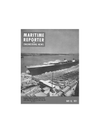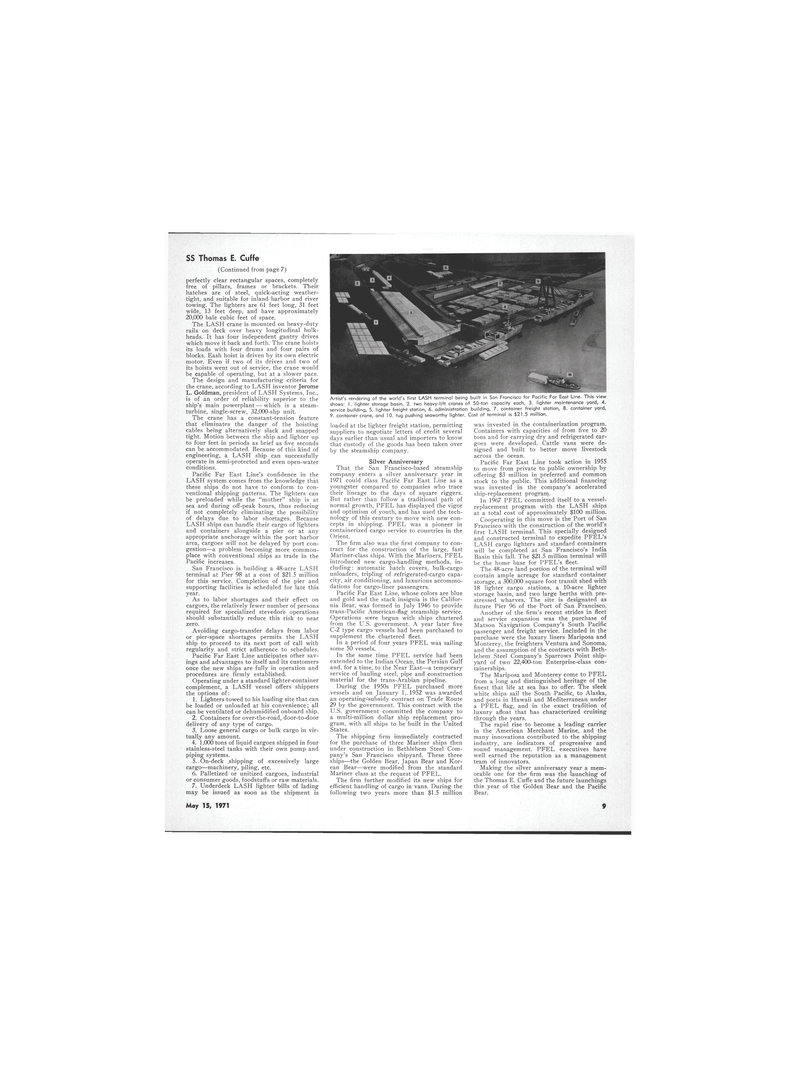
Page 7: of Maritime Reporter Magazine (May 15, 1971)
Read this page in Pdf, Flash or Html5 edition of May 15, 1971 Maritime Reporter Magazine
Artist's rendering of the world's first LASH terminal being built in San Francisco for Pacific Far East Line. This view shows: 1. lighter storage basin, 2. two heavy-lift cranes of 50-ton capacity each, 3. lighter maintenance yard, 4. service building, 5. lighter freight station, 6. administration building, 7. container freight station, 8. container yard, 9. container crane, and 10. tug pushing seaworthy lighter. Cost of terminal is $21.5 million.
SS Thomas E. Cuffe (Continued from page 7) perfectly clear rectangular spaces, completely free of pillars, frames or brackets. Their hatches are of steel, quick-acting weather- tight, and suitable for inland-harbor and river towing. The lighters are 61 feet long, 31 feet wide, 13 feet deep, and have approximately 20,000 bale cubic feet of space.
The LASH crane is mounted on heavy-duty rails on deck over heavy longitudinal bulk- heads. It has four independent gantry drives which move it back and forth. The crane hoists its loads with four drums and four pairs of blocks. Eash hoist is driven by its own electric motor. Even if two of its drives and two of its hoists went out of service, the crane would be capable of operating, but at a slower pace.
The design and manufacturing criteria for the crane, according to LASH inventor Jerome
L. Goldman, president of LASH Systems, Inc., is of an order of reliability superior to the ship's main powCrplant — which is a steam- turbine, single-screw, 32,000-shp unit.
The crane has a constant-tension feature that eliminates the danger of the hoisting cables being alternatively slack and snapped tight. Motion between the ship and lighter up to four feet in periods as brief as five seconds can be accommodated. Because of this kind of engineering, a LASH ship can successfully operate in semi-protected and even open-water conditions.
Pacific Far East Line's confidence in the
LASH system comes from the knowledge that these ships do not have to conform to con- ventional shipping patterns. The lighters can be preloaded while the "mother" ship is at sea and during off-peak hours, thus reducing if not completely eliminating the possibility of delays due to labor shortages. Because
LASH ships can handle their cargo of lighters and containers alongside a pier or at any appropriate anchorage within the port harbor area, cargoes will not be delayed by port con- gestion—a problem becoming more common- place with conventional ships as trade in the
Pacific increases.
San Francisco is building a 48-acre LASH terminal at Pier 98 at a cost of $21.5 million for this service. Completion of the pier and supporting facilities is scheduled for late this year.
As to labor shortages and their effect on cargoes, the relatively fewer number of persons required for specialized stevedore operations should substantially reduce this risk to near zero.
Avoiding cargo-transfer delays from labor or pier-space shortages permits the LASH ship to proceed to its next port of call with regularity and strict adherence to schedules.
Pacific Far East Line anticipates other sav- ings and advantages to itself and its customers once the new ships are fully in operation and procedures are firmly established.
Operating under a standard lighter-container complement, a LASH vessel offers shippers the options of: 1. Lighters towed to His loading site that can be loaded or unloaded at his convenience; all can be ventilated or dehumidified onboard ship. 2. Containers for over-the-road, door-to-door delivery of any type of cargo. 3. Loose general cargo or bulk cargo in vir- tually any amount. 4. 1,000 tons of liquid cargoes shipped in four stainless-steel tanks with their own pump and piping systems. 5. On-deck shipping of excessively large cargo—machinery, piling, etc. 6. Palletized or unitized cargoes, industrial or consumer goods, foodstuffs or raw materials. 7. Underdeck LASH lighter bills of lading may be issued as soon as the shipment is loaded at the lighter freight station, permitting suppliers to negotiate letters of credit several days earlier than usual and importers to know that custody of the goods has been taken over by the steamship company.
Silver Anniversary
That the San Francisco-based steamship company enters a silver anniversary year in 1971 could class Pacific Far East Line as a youngster compared to companies who trace their lineage to the days of square riggers.
But rather than follow a traditional path of normal growth, PFEL has displayed the vigor and optimism of youth, and has used the tech- nology of this century to move with new con- cepts in shipping. PFEL was a pioneer in containerized cargo service to countries in the
Orient.
The firm also was the first company to con- tract for the construction of the large, fast
Mariner-class ships. With the Mariners, PFEL introduced new cargo-handling methods, in- cluding: automatic hatch covers, bulk-cargo unloaders, tripling of refrigerated-cargo capa- city, air conditioning, and luxurious accommo- dations for cargo-liner passengers.
Pacific Far East Line, whose colors are blue and gold and the stack insignia is the Califor- nia Bear, was formed in July 1946 to provide trans-Pacific American-flag steamship service.
Operations were begun with ships chartered from the U.S. government. A year later five
C-2 type cargo vessels had been purchased to supplement the chartered fleet.
In a period of four years PFEL was sailing some 50 vessels.
In the same time PFEL service had been extended to the Indian Ocean, the Persian Gulf and, for a time, to the Near East—a temporary service of hauling steel, pipe and construction material for the trans-Arabian pipeline.
During the 1950s PFEL purchased more vessels and on January 1,. 1952 was awarded an operating-subsidy contract on Trade Route 29 by the government. This contract with the
U.S. government committed the company to a multi-million dollar ship replacement pro- gram, with all ships to be built in the United
States.
The shipping firm immediately contracted for the purchase of three Mariner ships then under construction in Bethlehem Steel Com- pany's San Francisco shipyard. These three ships—the Golden Bear, Japan Bear and Kor- ean Bear—were modified from the standard
Mariner class at the request of PFEL.
The firm further modified its new ships for efficient handling of cargo in vans. During the following two years more than $1.5 million was invested in the containerization program.
Containers with capacities of from five to 20 tons and for carrying dry and refrigerated car- goes were developed. Cattle vans were de- signed and built to better move livestock across the ocean.
Pacific Far East Line took action in 1955 to move from private to public ownership by offering $3 million in preferred and common stock to the public. This additional financing was invested in the company's accelerated ship-replacement program.
In 1967 PFEL committed itself to a vessel- replacement program with the LASH ships at a total cost of approximately $100 million.
Cooperating in this move is the Port of San
Francisco with the construction of the world's first LASH terminal. This specially designed and constructed terminal to expedite PFEL's
LASH cargo lighters and standard containers will be completed at San Francisco's India
Basin this fall. The $21.5 million terminal will be the home base for PFEL's fleet.
The 48-acre land portion of the terminal will contain ample acreage for standard container storage, a 300,000 square foot transit shed with 18 lighter cargo stations, a 10-acre lighter storage basin, and two large berths with pre- stressed wharves. The site is designated as future Pier 96 of the Port of San Francisco.
Another of the firm's recent strides in fleet and service expansion was the purchase _ of
Matson Navigation Company's South Pacific passenger and freight service. Included in the purchase were the luxury liners Mariposa and
Monterey, the freighters Ventura and Sonoma, and the assumption of the contracts with Beth- lehem Steel Company's Sparrows Point ship- yard of two 22,400-ton Enterprise-class con- tainerships.
The Mariposa and Monterey come to PFEL from a long and distinguished heritage of the finest that life at sea has to offer. The sleek white ships sail the South Pacific, to Alaska, and ports in Hawaii and Mediterranean under a PFEL flag, and in the exact tradition of luxury afloat that has characterized cruising through the years.
The rapid rise to become a leading carrier in the American Merchant Marine, and the many innovations contributed to the shipping industry, are indicators of progressive and sound management. PFEL executives have well earned the reputation as a management team of innovators.
Making the silver anniversary year a mem- orable one for the firm was the launching of the Thomas E. Cuffe and the future launchings this year of the Golden Bear and the Pacific
Bear.
May 15, 1971 9

 6
6

 8
8
